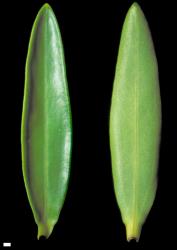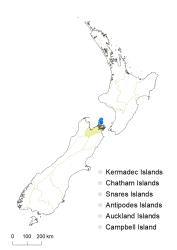- ≡ Hebe stenophylla var. oliveri Bayly & Garn.-Jones in Bayly et al., New Zealand J. Bot. 38: 182 (2000)
Stem pubescence glabrous to bifarious. Lamina lanceolate or elliptic, 22–37 mm long, 5–10 mm wide, glossy above; stomata sparse except near apex; minute pits near margins; margins usually glabrous or sometimes with very fine hairs. Inflorescence 26–60 mm long; pedicels puberulent or glabrous. Corolla tube 2.5–3.8 mm long, glabrous within.
The glossy and lanceolate to elliptic leaves of this variety resemble those on plants of V. urvilleana, which grows on nearby Rangitoto ki te Tonga / D’Urville I. However, the shorter inflorescences and corolla tubes, sparsely hairy corolla tube, and larger capsules of V. urvilleana distinguish it.
South Island: Sounds Nelson (Stephens and Trio Is.).
Wind-shorn scrub on exposed coastal cliffs. Recorded elevations range from 0 to 275 m.
Flowers: January–March; fruits: February–April (persisting longer).
2n = 40 (see Bayly & Kellow 2006, as Hebe stenophylla var. oliveri).





